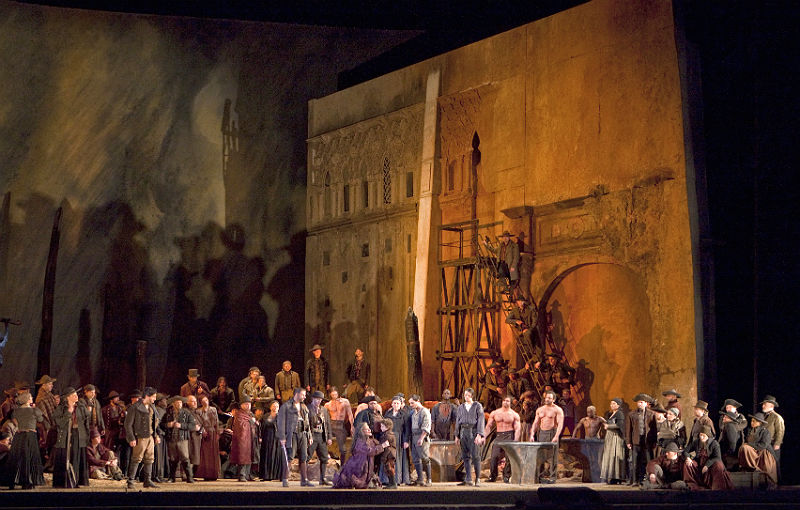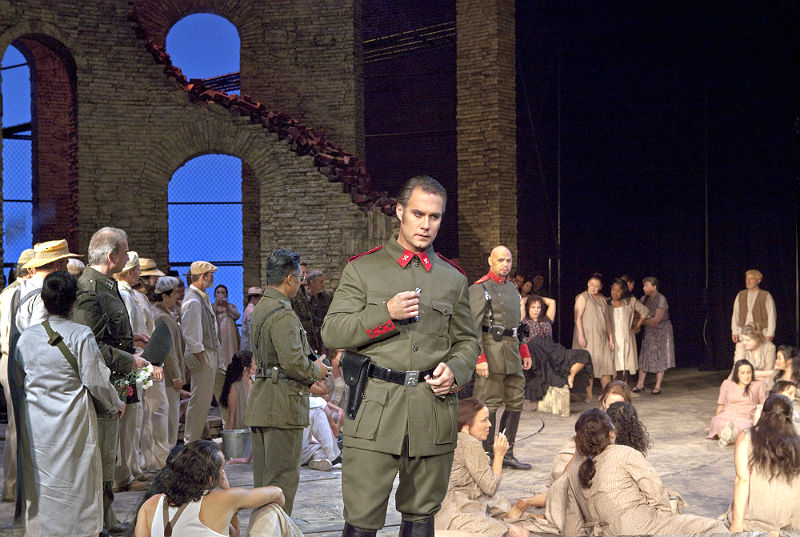By James Jorden
When stage directors decide to intervene (as opposed to merely curating) there are a number of approaches they can take: deconstruction, gloss on the text, invention of an entirely new narrative. Or they can take the somewhat safer route of changing the epoch of the action, setting La bohème during World War I, or in the 1950s, or even the present.
Now, in general, I’m not a fan of strict (i.e., realistic) updating, for a couple of reasons. For one, there are changes in technology and in society in general that have to be taken into account. An opera whose plot relies upon the urgent exchange of letters (e.g, Werther) tends to fall apart if the audience is given a chance to wonder why nobody just picks up the phone.
At the Met right now are two productions in the repertory, both composed in the 19th century, both standard pieces, both set in Spain. And both Il trovatore (directed by David McVicar) and Carmen (directed by Richard Eyre) are “updates.” The Verdi melodrama is moved forward from the 15th century to the early 19th century, to the era of the Peninsular War, with imagery deliberately referencing Goya’s harrowing “Los desastres de la guerra.”
A shift of period in a historical drama is always a mixed bag, but in the case of this production, the benefits far outweigh any pesky anachronisms. One particular plus is the strong focus on the wartime milieu. The guardroom of Aliaferia Palace (Act 1, Scene 1) looks genuinely bombed-out, and even the gypsy camp (Act 2, Scene 1) offers no glimpse of picturesque unspoiled nature. In fact, every scene of the work is placed before or beside some sort of towering wall that shows clear signs of recent attack by a violent enemy.
 Now, the war is not really key to the story of Il trovatore, which is essentially a personal and family tragedy. But the action of this opera is notorious for bizarre coincidences, sudden changes of heart and almost unrelenting violent emotion. So extravagant is Il trovatore that the dramatic element is generally regarded as not much more than camp: people just don’t behave this way.
Now, the war is not really key to the story of Il trovatore, which is essentially a personal and family tragedy. But the action of this opera is notorious for bizarre coincidences, sudden changes of heart and almost unrelenting violent emotion. So extravagant is Il trovatore that the dramatic element is generally regarded as not much more than camp: people just don’t behave this way.
However, people do behave in strange and unpredictable ways, even extravagant ways, when they are under enormous stress. And what more stressful situation than one of history’s bloodiest conflicts—and a well-documented one at that? Setting the work during this particular war offers the additional benefit that the uniforms and fashions of circa 1810 are simple in line and relatively unornamented, giving the costumes a far more modern (and therefore “real”) feel than the houppelands and tabards of the 1400s. Thus both the war in the background and the personal horrors in the foreground seem to be happening to real, identifiable people, not to opera singers in fancy dress.
This production illustrates one benefit of updating the period of an opera production, i.e., heightening the emotional impact through greater verisimilitude. In Carmen, Eyre seems to offer no such rationale. Like McVicar, he moves the action from a relatively vague and unspecific era (sometime in the first half of the 19th century) to a well-documented time frame, the late 1930s during the Spanish Civil War. So specific is the design for this production that the Act 1 set (a square in Seville) echoes documentary photography of the ruins of Guernica.
And yet Eyre doesn’t put his dislocation of era to any particular use, a real deficiency when the period in question is (again) one of history’s most notoriously violent. So potent a political issue was the Spanish Civil War that it still stands today as a primary symbol of anti-authoritarian resistance. But none of that political content seeps into Eyre’s reading. There is no war anywhere visible, not even in the background (except for those picturesque ruins), no sense of deadly risk in the smugglers’ defiance of authority, no sense of menace in all those soldiers lackadasically parading around.
To offer just one small example: in the final act, during the procession to the bullring, the children in the crowd sneer and yell “à bas! à bas!” to “l’alguazil à vilaine face.” Zuniga and several other soldiers are standing right there, and—nothing happens. Maybe Zuniga does a desultory “why I oughtta…” but other than that, nothing. In Fascist Seville, open insults in public to a (presumably) Franco partisan official, and everybody just shrugs, oh, you know, kids. That might have been a perfectly reasonable response in the 1830s when Spain was more or less at peace under fragmentary local governments. But when the director has taken pains to show that this is a Fascist society in the midst of war, it’s false.
So what does Eyre have to show for his updating? Well, Carmen gets to wear a strapless gown (all the rage in 1938) to the bullfight, and it does add an extra frisson to her struggle with Don José as we fret whether Elina Garanca will pop out of the top of her bodice. But, again, other than that: nothing. Eyre’s updating is a gimmick, a substitute for genuine thought about how to present an opera like Carmen in 2010.
[Photographs: Ken Howard/Metropolitan Opera]
Tags: bizet, carmen, david mcvicar, elina garanca, goya, il trovatore, lincoln center, metropolitan opera, richard eyre, verdi
